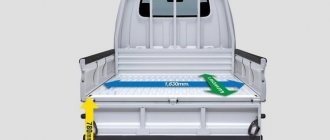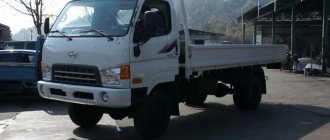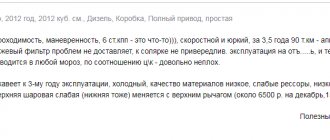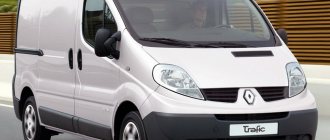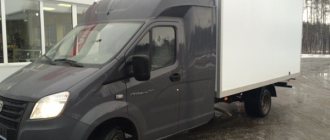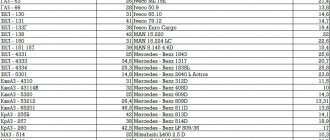The Hyundai Porter is a Korean-made small commercial truck with a payload capacity of up to 950 kg (the heavier version has a payload capacity of 1250 kg). This is a typical Asian model designed for urban transportation. Its compact dimensions make it ideal for dense city traffic, streets clogged with cars, and small spaces. Hyundai Porter combines the dynamics and convenience of a passenger vehicle with the great functionality inherent in a small class truck. These advantages are complemented by the affordable price and high quality of the car. This is what makes the Hyundai Porter incredibly popular on the world market and in Russia.
Model history and purpose
The first generation of the Hyundai Porter went into production in early 1977. The model was called HD1000 and was offered in two versions (truck and minibus). It received the name Hyundai Porter later. It is noteworthy that the product was produced under a license purchased from Mitsubishi. The car was an almost complete copy of the Mitsubishi L300/Delica/Truck. Production of the first generation ended in 1981.
In November 1986, the Hyundai Porter II was introduced. The model was also not independent and was produced under license from a Japanese partner as a more budget “clone” of the Mitsubishi Delica (L300). Externally, the Korean product was almost completely identical to its “brother.” In 1993, double and extended cab versions appeared. The main engines were a 2.5-liter Mitsubishi 4D56 diesel engine and a 4-cylinder Cyclone D4BX engine. The car existed until 1995.
3rd generation
In 1996, the debut of the third generation Hyundai Porter took place. The car received noticeable changes and had little in common with Mitsubishi models. The car received a dashboard from Hyundai Grace, a steering mechanism from a 1991 Hyundai Sonata. The picture was completed by large round headlights, a spacious cabin and an enlarged bumper. Externally, the car resembled a “tadpole”. The model was offered to the consumer with several types of bodies: 3- and 4-door van, 2- and 4-door truck.
Hyundai Porter III also entered the domestic car market. The model turned out to be very popular among Russians, who received a high-quality carrier for little money. This generation was sold on the domestic market even after the premiere of the next generation. The production of cars has been established at the TagAZ plant since 2005. In 2006, the model received the title “Best commercial vehicle in Russia.”
4th generation
In 2004, the fourth generation Hyundai Porter debuted.
The car retained its functional features, but was transformed in appearance. The main innovation was large modern block headlights, replacing round single headlights. The cabin lines have become smoother, which adds elegance to the model. In terms of design, the car could easily compete with European competitors. The fourth Hyundai Porter was manufactured in Korea, Brazil, Pakistan, and Malaysia. This model also became known as the Hyundai H-100. The car was equipped with 2.4-liter turbocharged diesel units (power 123, 126 and 133 hp). The model range included double and single cab options. Hyundai Porter IV was not delivered to Russia until 2013. The car will be the best option for light-duty transportation within the city and suburbs. It is distinguished by good maneuverability, small size and efficiency. In addition, the machine is convenient in terms of unloading and loading.
TagAZ Hyundai Porter - photo 1 Dynamic performance
| Technical characteristics of the Hyundai Porter The presence of many special modifications: a manipulator, a lift, an insulated van, a vehicle for emergency services and others have made the scope of the model very wide. And here I would like to note an interesting feature of the operation of the heating and cooling system in a comfortable mode for myself, I could not find it; out of about 10 gradations from cold to hot air, there is no position in which it would be completely comfortable, either hot or cold. no, no, no, no, but an unpleasant chill runs through. |
| Hyundai Porter fuel consumption - Automotive Magazine An impressive range of models allows you to choose a truck with the chassis configuration you need, an all-metal body with a van or an all-metal flatbed body with an awning. Porter 2 has a convenient option for buyers: you can choose the option with a manual 6-speed gearbox or with an automatic transmission equipped with 5 steps. |
- in the city 12.6 l;
- in mixed mode 10.3 l;
- on the highway 8 l.
Specifications
Hyundai Porter has the following dimensions:
- length – 4750 mm;
- width – 1690 mm;
- height – 1930 mm (with awning – 2420 mm);
- wheelbase – 2430 mm;
- ground clearance - 185 mm;
- front track – 1455 mm;
- rear track – 1380 mm.
Dimensions of the all-metal body:
- length – 2785 mm;
- width – 1600 mm;
- height – 355 mm.
Dimensions of the onboard platform with awning:
- length – 2785 mm;
- width – 1660 mm;
- height – 1700 mm.
The curb weight of the vehicle is 1660 kg, the load capacity is 950 kg (tilt version) and 1250 kg (flatbed version).
Dynamic characteristics:
- maximum speed – 160 km/h;
- acceleration to 100 km/h – 16.3 seconds.
Average fuel consumption in the combined cycle is 10.2 l/100 km. Fuel tank capacity – 60 l.
pros
If we compare the truck with the previous version, the Hyundai Porter 2 truck undoubtedly has a much more modern appearance, improved visibility and aerodynamics thanks to modified headlights, cab, side mirrors and doors. Yes, with regard to 1st gear, there is difficulty in turning on, especially in the heat of summer, but when shifting the throttle it turns on normally, although this problem can be eliminated, as the owners of analogues complained to me, it is necessary to securely fasten the release pedal system under the panel, supposedly the fastening there is not so firmly made, I haven’t climbed yet myself.
Engine
All modifications of the car for the Russian market are equipped with a turbodiesel unit. The turbocharged 8-valve overhead camshaft engine D4BF has a longitudinal arrangement and an electronic fuel injection pump (assembly is carried out in Taganrog). The power plant complies with the Euro-3 environmental class. The engine of this family is based on the common Mitsubishi 4D56 unit.
Characteristics of the power plant (basic version):
- working volume – 2.47 l;
- rated power - 80 hp;
- maximum torque – 200 Nm;
- number of cylinders – 4 (in-line arrangement).
The D4BF unit is distinguished by excellent traction forces and sufficient throttle response. At the same time, it is also quite economical.
First Force: Threat of Invasion by New Players - Design Features
| Hyundai Porter 2.5 fuel consumption per 100 km For a long time, the hegemon was GAZelle, which, like no other, met the needs of its audience: optimal load capacity, several people can fit in the cabin, spare parts can be bought at any dealership, the cost of purchasing a car is relatively low, and so is ownership . The interior layout is designed on the basis of a passenger car: easy landing, a wide range of seat adjustments, ergonomic arrangement of control mechanisms and easy-to-read instruments. |
- The turbocharger that the car is equipped with needs to be used properly. When the driver puts the engine under maximum load and then turns it off, the oil in the bearings is completely burned out. The next time the engine is started, the turbine operates without oil. Which leads to its failure. To prevent this from happening, you need to install a turbo timer. You can do without additional costs. To do this, after parking the car, you should not immediately turn off the engine. It needs to be allowed to idle for a few minutes. In order not to waste time on this, the last minutes of the journey should be driven at a minimum speed without using turbine power.
- Low quality fuel can quickly lead to engine failure. To solve the problem, you should refuel your car at good branded gas stations.
- It is not recommended to operate the engine at maximum speed. The car is not designed for this.
- The fuel filter is an element that needs to be changed regularly. The manufacturer regulates this to be done every 10 thousand kilometers. Some motorists change it at least once every 5 thousand kilometers.
Device
Hyundai Porter stands out for its high build quality. The car is based on a frame structure, characterized by increased reliability. The car consists of a spacious cabin located above the engine and equipped with three seats, and a chassis mounted on a rigid steel frame consisting of several sections. From the cabin you can reach the engine. The steel used for the body frame is of high quality and ensures trouble-free operation of the structure for many years. Thanks to the low loading height, the process of unloading or loading goods is as easy as possible. The design of the Hyundai Porter is designed with an eye to moving in dense city traffic and constant maneuvering. Compact dimensions and good visibility in all directions make it easier to control the machine.
The layout of the car is thought out very well. When turning the key, the driver will not hear any rattling from the engine. Instead, he will only feel a slight tremor. Hyundai Porter is light and fast. The car will appeal to those who like to drive with frequent maneuvers, as it allows them to be performed with confidence. The car's handling is excellent. The vehicle reacts instantly to movements of the pedal or steering wheel. A large load has virtually no effect on the nature of transportation. The small size makes you feel like you're in a car.
The car is equipped with front independent suspension and rear dependent leaf spring suspension. Telescopic shock absorbers and stabilizers make the car more stable and dampen strong vibrations. The model's suspension provides high ride comfort even on Russian roads. The Hyundai Porter uses a rack and pinion steering mechanism. The basic configuration includes power steering.
The braking system uses a dual-circuit hydraulic system with a vacuum booster and diagonal division into circuits. The front wheels are equipped with ventilated disc brakes, the rear wheels are equipped with drum brakes. The brake system has sufficient tenacity. ABS is available as an option.
The Hyundai Porter is supplied to the domestic market with a 5-speed manual transmission. Transmission gears shift clearly and smoothly.
The interior of the Hyundai Porter will also please the owner. The basic configuration of the model includes electric windows, a tool box and 2 spare wheels. The car cabin is designed for three people, but only two can comfortably fit in it. The middle chair is usually used as a table. In this arrangement, the driver and passenger feel very free. The quality of the finish of the car is reminiscent of passenger cars. The driver's seat in the Hyundai Porter is adjustable in terms of backrest and longitudinal tilt. The lateral support of the chair adds comfort. The seat upholstery is very good. Plastic, despite its budget design, is pleasant to the touch.
The instrument cluster is easy to read and located in a convenient location. The steering column does not obscure it. Temperature control is carried out using slide switches. An interesting feature of the model is the lock on the gas tank.
Disadvantages of Hyundai Porter:
- an open battery regularly becomes dirty, causing the contacts to quickly oxidize;
- low ceiling in the cabin (drivers taller than 185 cm will feel uncomfortable);
- a high center of gravity (typical of vans) can cause the vehicle to roll onto its side.
Hyundai Porter repair
Despite all its advantages, this car has several objective disadvantages. Truck repair is most often required for these reasons:
- an open configuration battery constantly becomes dirty, which leads to rapid oxidation of the contacts;
- an elevated center of gravity (especially in vans) can cause the car to roll onto its side;
- malfunction of the heating system.
In any case, domestic consumers do not have any difficulties in terms of repairs, thanks to the unification of some spare parts and the decent development of dealer and service centers. True, the cost of original parts is quite high.
Hyundai Porter reviews
- Anton, Moscow: the car is of very high quality. Previously, I worked with domestic cars that constantly broke down. In 2013, I decided to update the transport. Porter chose Hyundai because of its low cost and good reviews on the Internet. In addition, the car has small dimensions, which makes parking on Moscow streets much easier. Cars have free entry into the city center, which is an additional advantage. The seating position is very comfortable. Over the 3 years of operation, I only changed consumables. Sometimes I loaded the car to capacity (often I drove with overload). At the same time, the engine still pulled well and consumed little fuel. True, in a crosswind the car turned out to be very unstable. Among other disadvantages, I would like to highlight the too “abstruse” design. So, getting to the motor is very problematic. Otherwise, I liked the car. By the way, category B rights are enough to manage it.
- Andrey, Blagoveshchensk: bought a Hyundai Porter in 2015. So far he has only positive emotions. I bought a used version. After the purchase, I went for a technical inspection, where the chassis was tampered with and some consumables were replaced. I didn’t experience any particular problems with spare parts - they are all available in stores and markets. True, they are not cheap. The inside of the car is quite decent. I liked the handling of the Hyundai Porter: good turning and maneuverability, excellent traction. Fuel consumption is normal (no more than 11 liters in the city). High ground clearance and compact dimensions make parking easy. By car you can safely drive onto curbs. The car is really good, I recommend it.
Brake system - Basic faults
| Fuel consumption of Hyundai Porter: 2.5 per 100 km | — A guide to fuel consumption per 100 km of travel There are no complaints about diesel fuel consumption; on average, in summer it burns 10-11 liters per 100 km, in winter a maximum of 1 liter more, but in rare cases the figures exceed the official norm. It is for its thoroughly thought-out and high-quality chassis that many domestic drivers give preference to the Hyundai Porter when choosing a commercial vehicle. |
- very low cabin ceiling;
- insufficient amount of free space for the driver;
- battery insecurity;
- instability of the truck due to the high center of gravity.
Causes of problems with D4BF • Another Hyundai model called Galloper is also equipped with a D4BF engine.
Options
The standard Plus package includes: power steering, power windows, electric and heated mirrors, front spherical parking mirror, central locking, radio, air conditioning, central locking, tachometer, tool box, fog lights, two spare wheels.
The Super package adds to the specified options an adjustable steering column, an electrically heated driver's seat, an automatic driver's electric window, a visor with a mirror (on the passenger side), and a compartment for glasses. The Hi-Super package adds options such as: radio and telephone controls on the steering column; electric folding mirrors; wood-effect front panel trim, parking sensors, a more expensive radio with additional mini-speakers, USB port + iPod.
Hyundai Porter 2 with standard cab.
In any configuration, for an additional fee, you can add the following options to your choice: five-speed automatic transmission, driver airbag, ABS - anti-lock brakes, electric heated driver's seat, rear parking sensors, self-locking rear axle (LD), power take-off (PTO), spoiler for the cabin.
Unlike the previous generation, Porter 2 is available with three types of cabins: STD (standard), King (extended, but not with a berth, but with a luggage compartment for a row of seats) and Double (double) and bases of various lengths: STD (standard ), Long (extended) and Extra long (extra-long). For vehicles with a regular cab, the length of the cargo platform is 2.89 m. With an extended cab – 2.5 m. With a double cab – 1.89 m.
With extended cab.
With all its “innovations and upgrades,” the Hyundai Porter 2 managed to maintain a low cost compared to other compact trucks in its class.
